victims
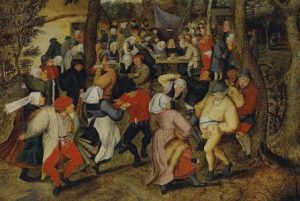
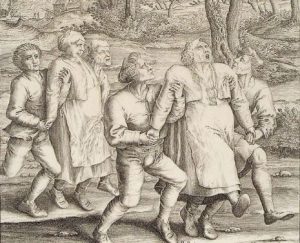 Many of us have heard of “dance mania” or “dance fever,” but I wonder how many people realize that those were real things. There have been a number of times in history when people were suddenly compelled to dance without stopping. In fact, they really couldn’t stop until they fell down with exhaustion. Then they would sleep a while, and start all over again. Many times the victim of this disease, would cry out in pain, begging someone to help them. They could not stop. Their feel would blister and bleed. Their muscles would spasm. Tears would flow from their eyes, but still they danced. Some people danced until they actually fell down dead.
Many of us have heard of “dance mania” or “dance fever,” but I wonder how many people realize that those were real things. There have been a number of times in history when people were suddenly compelled to dance without stopping. In fact, they really couldn’t stop until they fell down with exhaustion. Then they would sleep a while, and start all over again. Many times the victim of this disease, would cry out in pain, begging someone to help them. They could not stop. Their feel would blister and bleed. Their muscles would spasm. Tears would flow from their eyes, but still they danced. Some people danced until they actually fell down dead.
The Strasbourg plague started with Frau Troffea in July of 1518. That day, she just stepped outside her small home in Strasbourg and started to dance. She might have seemed happy, but she didn’t stop. Frau Troffea danced the entire day. Her husband was not happy. No cleaning was done, no cooking, and if they had children, they weren’t taken care of either. She only stopped dancing when she collapsed that night for a few hours of restless sleep. Then, with the sun rise, she began dancing again. To the horror of her husband, a crowd gathered around his dancing wife, who swayed to the sound of silence. There was no music…except maybe in her head. She paid no attention to anything going on around her. She just danced, even though her feet were bloody and bruised. It was almost as if she was just crazy, but that couldn’t be it, because within days, at least thirty other dancers had joined Frau Troffea. It was just the beginning of the strangest plague to strike medieval Europe. The people called it “dancing mania,” and it soon spread to even more people in Strasbourg. A reporter at that time, Daniel Specklin said that there were “more than one hundred” dancing at the same time. Someone else estimated the number at closer to four hundred. The strange epidemic quickly became a crisis for the city of Strasbourg, and the city council had no idea how to stop the dancing, which is a strange idea to me anyway. What could the city council do, if the doctors couldn’t help?
The only thing anyone was sure of, was that…the dancers were not happy. They writhed in pain. They begged for mercy. They screamed for help. As summer stretched on, the dancing epidemic started to claim lives. One chronicle reported that during the heat of the summer, as many as fifteen people died every day from dancing. It makes sense, they probably couldn’t stop to eat or drink. Exhaustion, dehydration, and starvation finally took their toll, and the victim simply died. Thinking it might be a curse, the city cracked down on the possible connection to sin. Brothels and gambling houses were closed. Everyone knew that gaming and prostitution angered the saints, who might have sent the dancing plague to punish Strasbourg. So, the city rounded up all the “loose persons” and banished them from the city. It didn’t help. They prayed and lit candles, hoping that a return to their faith might lift the “curse” for the town. They banned dancing, effectively making all the victims, “criminals” as well.
Desperate, as the end of summer neared and the dancing mania continued, the city took a drastic step. A reporter of the time described the cure. “They sent many on wagons to St. Vitus,” a shrine at the top of a mountain. The dancers continued to fall down in front of the altar, so the priest said Mass over them, and “they were given a little cross and red shoes, on which the sign of the cross had been made in holy oil, on both the 
 tops and the soles.” It was thought that they were possessed. The red shoes did the trick. The dancing epidemic slowly came to an end, and most of the dancers regained control of their bodies. The strange ailment started to be called “St. Vitus’ Dance,” either because the saint had cured the dancers, or because he was responsible for the original curse. Strange idea either way. Whether they were possessed, or the “illness” just ran it’s course, the trip to Saint Vitus marked the beginning of the end of the Dancing Plague. It is now believed that the people suffered from mass hysteria, due to the stresses of the day. A Small Pox plague and a Leprosy plague had been through the area, as well as several years of failed crops and famine. It makes sense I guess, but what a strange way for it to manifest. Apparently, a trip to the church to see the priest was enough to calm their fears and stop the plague.
tops and the soles.” It was thought that they were possessed. The red shoes did the trick. The dancing epidemic slowly came to an end, and most of the dancers regained control of their bodies. The strange ailment started to be called “St. Vitus’ Dance,” either because the saint had cured the dancers, or because he was responsible for the original curse. Strange idea either way. Whether they were possessed, or the “illness” just ran it’s course, the trip to Saint Vitus marked the beginning of the end of the Dancing Plague. It is now believed that the people suffered from mass hysteria, due to the stresses of the day. A Small Pox plague and a Leprosy plague had been through the area, as well as several years of failed crops and famine. It makes sense I guess, but what a strange way for it to manifest. Apparently, a trip to the church to see the priest was enough to calm their fears and stop the plague.
 As children, most of us have been on the receiving end of a form of “torture” that really isn’t exactly torture for most of us, but rather just good clean fun…provided that the torturer knows when to stop. My sisters and I were among the experts of our era…at least four of us were. The fifth sister, the middle one, Caryl Reed, was an “accomplished” victim…not because she chose to be the victim, but rather that she was the one we most loved to tickle. She was just such a great victim!! We would tickle her until she could hardly breathe, and then we would show some “mercy” and let her “live to be victimized another day.”
As children, most of us have been on the receiving end of a form of “torture” that really isn’t exactly torture for most of us, but rather just good clean fun…provided that the torturer knows when to stop. My sisters and I were among the experts of our era…at least four of us were. The fifth sister, the middle one, Caryl Reed, was an “accomplished” victim…not because she chose to be the victim, but rather that she was the one we most loved to tickle. She was just such a great victim!! We would tickle her until she could hardly breathe, and then we would show some “mercy” and let her “live to be victimized another day.”
I always thought my sisters, Cheryl Masterson, Alena Stevens, Allyn Hadlock, and I were very clever at coming up with something totally new…the Tickle Torture, but it turns out that Tickle Torture is an ancient form of actual torture. Who knew? Certainly not my sisters or me. Our form of torture, barely resembles the ancient form, or the form that still exists to this day among military circles. As it turns out, the tickle torture began in 260 BC, as far as anyone can tell, when the Han Dynasty appears to have implemented the technique as a reliable punishment that didn’t leave marks. It was used by 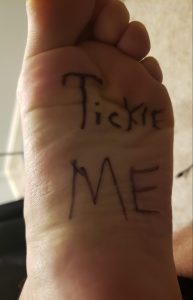 both the Ancient Romans and the Chinese. I have heard of some of the brutal forms of torture that the Romans used, and I suppose at first this seemed like one of the most humane forms of torture in their entourage. It seems that they would apply salt on the soles of feet and then have a goat lick it off. If you have ever had an animal lick your hand, you know that they usually have a rough tongue. At first, the torture must have been crazy in an extremely ticklish sort of way, and very likely the victim laughed until they could hardly breathe. As the torture continued, the rough tongue of the goat began to actually cause extreme pain…sometimes even lacerating the skin of the feet. The Chinese used this torture on the nobility because there was little evidence left behind and recovery was quick.
both the Ancient Romans and the Chinese. I have heard of some of the brutal forms of torture that the Romans used, and I suppose at first this seemed like one of the most humane forms of torture in their entourage. It seems that they would apply salt on the soles of feet and then have a goat lick it off. If you have ever had an animal lick your hand, you know that they usually have a rough tongue. At first, the torture must have been crazy in an extremely ticklish sort of way, and very likely the victim laughed until they could hardly breathe. As the torture continued, the rough tongue of the goat began to actually cause extreme pain…sometimes even lacerating the skin of the feet. The Chinese used this torture on the nobility because there was little evidence left behind and recovery was quick.
People have mixed feelings on tickling. Some like it, but some don’t. I have always been of the mind that if someone really hates it, it should not be done. Of course, the victims in those days had no choice, and I doubt if anyone really liked that kind of tickle torture. I guess that if a person really hates the tickle torture, they might be able to understand how some groups in history have come up with ways to turn it into an actual form of torture. In the actual torture, people might pass out, vomit, and some even died…at least it went that far in the Nazi concentration camps during World War II. I suppose that for anyone who lived through any of that or knew someone who did, the tickle torture would not be funny at all. Still, tickle torture was not as bad as some  of the other forms of torture used in ancient times, nor was it often as deadly as those other forms.
of the other forms of torture used in ancient times, nor was it often as deadly as those other forms.
Actual Tickle torture is still in use today too, and not just in various households across the world. Special operations forces may actually use it in interrogations, as a method of non-lethal torture to be employed by governments to gain information from a suspect. I don’t know how they would actually get any information for a victim, unless their form of torture took a painful turn, but then I’m not an interrogator, so maybe they know something I don’t. What I do know is that my sisters and I had many happy sessions of applying the tickle torture to our sister, Caryl.
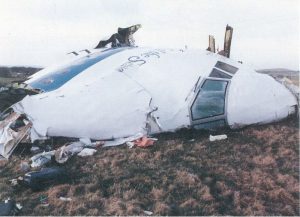 On December 21, 1988, at 7:00pm, Pan Am Flight 103 from London to New York exploded in midair over Lockerbie, Scotland, killing all 243 passengers and 16 crew members aboard, as well as 11 Lockerbie residents on the ground. A bomb hidden inside an audio cassette player detonated in the cargo area when the plane was at an altitude of 31,000 feet. The disaster, which became the subject of Britain’s largest criminal investigation, was believed to be an attack against the United States, because although the passengers came from 21 countries, the majority, 189 of the 259 victims on the plane were American. Islamic terrorists were accused of planting the bomb on the plane while it was at the airport in Frankfurt, Germany. The investigation lasted for years, 15,000 people were interviewed and 180,000 pieces of evidence were examined. Finally, in 2001, Mohmed al-Megrahi was convicted and sentenced to 20…and later 27 years in prison. Lamin Khalifa Fhimah was acquitted, and the Libyan government eventually agreed to pay damages to the families of the victims.
On December 21, 1988, at 7:00pm, Pan Am Flight 103 from London to New York exploded in midair over Lockerbie, Scotland, killing all 243 passengers and 16 crew members aboard, as well as 11 Lockerbie residents on the ground. A bomb hidden inside an audio cassette player detonated in the cargo area when the plane was at an altitude of 31,000 feet. The disaster, which became the subject of Britain’s largest criminal investigation, was believed to be an attack against the United States, because although the passengers came from 21 countries, the majority, 189 of the 259 victims on the plane were American. Islamic terrorists were accused of planting the bomb on the plane while it was at the airport in Frankfurt, Germany. The investigation lasted for years, 15,000 people were interviewed and 180,000 pieces of evidence were examined. Finally, in 2001, Mohmed al-Megrahi was convicted and sentenced to 20…and later 27 years in prison. Lamin Khalifa Fhimah was acquitted, and the Libyan government eventually agreed to pay damages to the families of the victims.
The lateness of the explosion made much of the recovery impossible until the stark light of day, when the horror really became clear to the world. The reasons for the attack, in the minds of Islamic terrorists were to destroy life as much as possible, and I’m sure they thought they had succeeded. Yes, the people who died and their family, will never get over their loss. It just doesn’t work that way. It never goes away, but out of that tragedy, came something amazing too…the Lockerbie Heroes.
Lockerbie is a small town in Scotland, and something like this attack is unheard of. Such things seemed so far 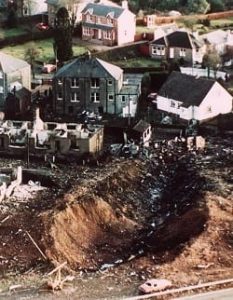 away, but as we all know, such things can come to small towns, and it is then that these little hamlets take center stage…sometimes for a short time, sometimes for years, and sometimes its forever. This small town took it upon themselves, to make a difference. Most of us would run away from the horror, or hide so we didn’t have to face it, but not the citizens of Lockerbie. Every member of this town turned out, and with no specific plan in place, they simply started to help. On that December day in 1988, a Pan Am flight had blown up, and hundreds of pieces of metal, random, objects, and body parts come raining out of the sky.
away, but as we all know, such things can come to small towns, and it is then that these little hamlets take center stage…sometimes for a short time, sometimes for years, and sometimes its forever. This small town took it upon themselves, to make a difference. Most of us would run away from the horror, or hide so we didn’t have to face it, but not the citizens of Lockerbie. Every member of this town turned out, and with no specific plan in place, they simply started to help. On that December day in 1988, a Pan Am flight had blown up, and hundreds of pieces of metal, random, objects, and body parts come raining out of the sky.
Most of us assume that we would go into state of panic, but the people of Lockerbie didn’t have time to panic. They were too busy diving into the wreckage to collect any personal items they might find. No, not to keep them or sell them on eBay, it was the 80’s after all. They did it simply to comfort the victim’s families. In order to store the tens of thousands of debris pieces that had been scattered over 845 square miles, the first thing the townspeople did was build a warehouse. Any items that weren’t of forensic value were left for the townspeople to organize. These The compassionate people of Lockerbie knew that they couldn’t hand them to the bereaved families looking so ugly. The reality was that seeing these items in the condition they were now, would be pure torture. The townspeople decided to perform an act of love and compassion. Working as a gigantic assembly line of washers and dryers and ironers and folders, the townspeople restored the countless items of clothing scattered across the charred, muddy, usually quite apocalyptic landscape. They developed rolls and film and put diaries back together to identify the owners, while any stray rings, wallets, and other effects were carefully matched up to the corresponding suitcase. In one instance, the State Department informed one family that they couldn’t have their daughter’s stuff back because it was “too badly damaged.” The people of Lockerbie scoffed at that and un-damaged it. What a gift. You can’t help but cry and the enormity  of their kindness.
of their kindness.
Before long, the relatives flocked to Lockerbie in order to be near to the site of the crash. The town opened its doors and took them in, setting the foundation for friendships that still survive today. Christmas cards are exchanged, letters are written, and families still journey to the town. It takes a lot of awesome to turn a town from “giant crater where my loved one died” to “place of friendship and comfort.” As the years have passed, the people coming aren’t as many, but the town of Lockerbie and the world remember each and every victim.

 Most people who were alive in 1980, remember the catastrophic eruption of Mount Saint Helens on May 18th, but I wonder how many people…at least people who didn’t live in Washington state at that time…remember the earlier eruption that took place on March 29th. Volcanic eruptions don’t usually bring loss of life these days, because there are so many warning signs. That is what made the 57 lives lost to the Mount Saint Helens blast on May 18th so devastating. The warnings were there. The people were told, but the ones who lost their lives chose to stay in the area anyway, despite the glaring changes in the mountain and the urgent warnings to stay away. We had all heard that there was a distinct possibility that the mountain was going to blow. It was not just the people in Washington who were warned, but all across the nation too. I vividly remember being told what to expect when the mountain blew, because they knew the ash would encircle the entire Earth before it was all said and done.
Most people who were alive in 1980, remember the catastrophic eruption of Mount Saint Helens on May 18th, but I wonder how many people…at least people who didn’t live in Washington state at that time…remember the earlier eruption that took place on March 29th. Volcanic eruptions don’t usually bring loss of life these days, because there are so many warning signs. That is what made the 57 lives lost to the Mount Saint Helens blast on May 18th so devastating. The warnings were there. The people were told, but the ones who lost their lives chose to stay in the area anyway, despite the glaring changes in the mountain and the urgent warnings to stay away. We had all heard that there was a distinct possibility that the mountain was going to blow. It was not just the people in Washington who were warned, but all across the nation too. I vividly remember being told what to expect when the mountain blew, because they knew the ash would encircle the entire Earth before it was all said and done.
For a week, prior to March 29th, the area had been hit with small earthquakes below the mountain. These earthquakes were an indication that magma had begun to move below the volcano. On March 20, at 3:45pm Pacific Standard Time, a shallow magnitude 4.2 earthquake centered below the volcano’s north flank, signaled the volcano’s violent return from 123 years of hibernation. Over the 20th and 21st, 174 earthquakes of 2.6 or greater hit the area. At 12:36pm on March 27th, phreatic eruptions (explosions of steam caused by magma 
 suddenly heating groundwater) ejected and smashed rock from within the old summit crater, opening a new crater 250 feet wide, and sending an ash column about 7,000 feet into the air. On March 29th, an eruption of Mount Saint Helens blasted a mushroom cloud over most of the state of Washington. Then on May 18, 1980, came the catastrophic blast that took the lives of those who had stayed, even with the many warning signs, and public warnings.
suddenly heating groundwater) ejected and smashed rock from within the old summit crater, opening a new crater 250 feet wide, and sending an ash column about 7,000 feet into the air. On March 29th, an eruption of Mount Saint Helens blasted a mushroom cloud over most of the state of Washington. Then on May 18, 1980, came the catastrophic blast that took the lives of those who had stayed, even with the many warning signs, and public warnings.
I understand the rights of people to make their own decisions concerning their safety, but when warnings are given, the choices people make need to be taken into account before allowing any lawsuits to take place. Of course, as with any kind of disaster, people want someone to blame for the pain they are feeling over the loss of their loved ones. In this case it appears that the safe zone might have been miscalculated, but it is my belief that we are also responsible for our own safety. I remember thinking that I didn’t want to be anywhere near that mountain in those days. Of the 57 people killed, the Weyerhaeuser Company and representatives of 14 victims of the Mount Saint Helens’ 1980 eruption filed lawsuits. The plaintiffs alleged in a King County Superior Court suit that Weyerhaeuser misrepresented the danger posed by the volcano and misled loggers and others into believing it was safe to be near the peak. Maybe they did, but the trial ended in a hung jury. They could not agree either. To me it seems as if this blast was nothing like the normal eruptions people knew about. In the end, the plaintiffs settled out of court for a reported $225,000, but the forest products company still denies 
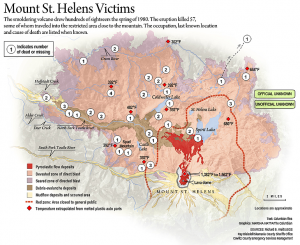 liability. I don’t claim to know whether or not these 14 victims were wronged or if they simply didn’t take their own safety into account when they went too near the action. I do know that at the time, it made no sense to me to be anywhere near a mountain that was so filled with pressure that it was bulging. I thought that was a warning in itself. I remember the public warnings about the mountain. It simply made no sense to take the chance.
liability. I don’t claim to know whether or not these 14 victims were wronged or if they simply didn’t take their own safety into account when they went too near the action. I do know that at the time, it made no sense to me to be anywhere near a mountain that was so filled with pressure that it was bulging. I thought that was a warning in itself. I remember the public warnings about the mountain. It simply made no sense to take the chance.
 When a crime is committed, it seems to take forever to bring justice for the victims. Sometimes people just don’t want to wait, or they are so mad about the crime committed against them or their family, that they decide, either consciously or unconsciously, to take matters into their own hands. This is known as vigilante justice, and while we still have it today, it really was more prevalent in the Old West….at least as it applies to storming the jail and hanging the “criminal” accused of the crime, without a trial.
When a crime is committed, it seems to take forever to bring justice for the victims. Sometimes people just don’t want to wait, or they are so mad about the crime committed against them or their family, that they decide, either consciously or unconsciously, to take matters into their own hands. This is known as vigilante justice, and while we still have it today, it really was more prevalent in the Old West….at least as it applies to storming the jail and hanging the “criminal” accused of the crime, without a trial.
Vigilante justice was more common in the wild west days because law enforcement was almost non-existent. Vigilantes took it upon themselves to “enforce the law,” as well as their own moral code, even if the event was not necessarily against the law. When a mob would decide that a prisoner is guilty, they would storm the jailhouse, drag the prisoner out, down the street to a big tree, and there they would hang the prisoner, whether they were guilty or not. The mob had decided. I suppose that a lot of times the person who was hanged was guilty of the crime, but without a trial and evidence to prove their guilt, how could anyone be sure?
The term vigilante stems from the its Spanish equivalent, meaning private security agents, but the vigilantes of 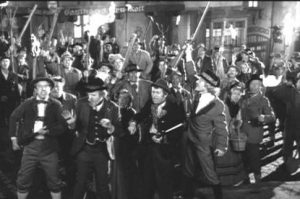 the old west and the mobs, who riot for their idea of right these days, have little in common with security agents. Most vigilantes and mobs are driven anger and adrenaline. Unfortunately those two things together don’t often bring a good outcome, and in the case of lynch mobs, it’s never a good outcome. Old West vigilantes were most common in mining communities, but were also known to exist in cow towns and in farming settlements. These groups usually formed before law and order existed in a new settlement. The justice dished out included whipping and banishment from the town, but more often, offenders were lynched. And sometimes the vigilante groups formed in places where lawmen did exist, but were thought to be weak, intimidated, or corrupt.
the old west and the mobs, who riot for their idea of right these days, have little in common with security agents. Most vigilantes and mobs are driven anger and adrenaline. Unfortunately those two things together don’t often bring a good outcome, and in the case of lynch mobs, it’s never a good outcome. Old West vigilantes were most common in mining communities, but were also known to exist in cow towns and in farming settlements. These groups usually formed before law and order existed in a new settlement. The justice dished out included whipping and banishment from the town, but more often, offenders were lynched. And sometimes the vigilante groups formed in places where lawmen did exist, but were thought to be weak, intimidated, or corrupt.
Some people see vigilantes as heroes, thereby giving them he support of some of the law-abiding citizens. Some people saw them as a necessary step to fill a much needed gap. Nevertheless, sometimes the vigilance committee began to wield too much power and became corrupt themselves. At other times, vigilantes were nothing more than ruthless mobs, attempting to take control away from authorities or masking themselves as “do-gooders” when their intents were little more than ruthless or they had criminal intent on their own minds. One of the first vigilante groups formed was the San Francisco Vigilantes of 1851. After several criminals were hanged the committee was disbanded. When the city administration, itself, became corrupt, a vigilante group formed once again in 1856. There were many vigilante groups formed in the American West. The Montana 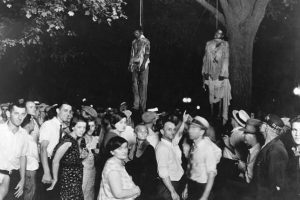 Vigilantes who hanged Bannack Sheriff Henry Plummer in 1864. They controlled the press, so the sheriff was made out to be the leader of an outlaw gang called the Innocents. Further investigation indicates that it might have been the vigilante group, themselves, who were behind the chaos reigning in Montana and that Henry Plummer was an innocent man. Following the Civil War, the Reno Gang began to terrorize the Midwest, resulting in the formation of the Southern Indiana Vigilance Committee. The next time the Reno Gang attempted to rob a train, a the vigilante group lynched its leaders…Frank, William and Simeon Reno. Vigilantes did good in some instances, but it was not really the best form of justice.
Vigilantes who hanged Bannack Sheriff Henry Plummer in 1864. They controlled the press, so the sheriff was made out to be the leader of an outlaw gang called the Innocents. Further investigation indicates that it might have been the vigilante group, themselves, who were behind the chaos reigning in Montana and that Henry Plummer was an innocent man. Following the Civil War, the Reno Gang began to terrorize the Midwest, resulting in the formation of the Southern Indiana Vigilance Committee. The next time the Reno Gang attempted to rob a train, a the vigilante group lynched its leaders…Frank, William and Simeon Reno. Vigilantes did good in some instances, but it was not really the best form of justice.
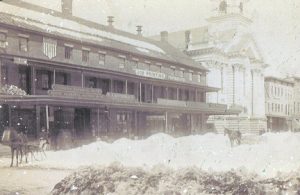 With all of the extreme weather shows, warnings, and education we have access to these days, one would think that blizzard related deaths would quickly become a thing of the past, but it never seems to go that way exactly. Nevertheless, it used to be much worse. In bygone years, the warnings we have today simply didn’t exist, and blizzards were very much feared by the people, and with good reason too. The storms would come up, seemingly without notice, and I suppose that was how it was. People couldn’t turn on their radio, television, computers, or smart phones, and get the weather forecast. They could look at the sky and feel the temperature changing, and maybe guess at what was coming, but if they were wrong, it could be deadly. Such was the case on January 12, 1888, when a blizzard blew into the Northwest Plains region of the United States with little or no warning. Some people said that the temperature dropped 100° in just 24 hours. A lot maybe, but I’ve seen temperature changes of more than 60°, so it’s possible.
With all of the extreme weather shows, warnings, and education we have access to these days, one would think that blizzard related deaths would quickly become a thing of the past, but it never seems to go that way exactly. Nevertheless, it used to be much worse. In bygone years, the warnings we have today simply didn’t exist, and blizzards were very much feared by the people, and with good reason too. The storms would come up, seemingly without notice, and I suppose that was how it was. People couldn’t turn on their radio, television, computers, or smart phones, and get the weather forecast. They could look at the sky and feel the temperature changing, and maybe guess at what was coming, but if they were wrong, it could be deadly. Such was the case on January 12, 1888, when a blizzard blew into the Northwest Plains region of the United States with little or no warning. Some people said that the temperature dropped 100° in just 24 hours. A lot maybe, but I’ve seen temperature changes of more than 60°, so it’s possible.
It was a Thursday afternoon and the weather had been unseasonably warm the previous day from Montana, east to the Dakotas, and south to Texas. Within a matter of hours, the Artic front blew in, plunging the temperature to 40° below zero in much of North Dakota. The freezing temperatures were joined by high winds and heavy snow. It was lethal combination that created a blinding blizzard, just when the children were on their 

 way home from school. The storm, coupled with the time of day, set the stage for a disaster, and unfortunately it would take the lives of 235 people…mostly children making their way home from school in rural areas and adults working on large farms. Both of these groups of people were taken by surprise, and were unable to find their way to their destinations.
way home from school. The storm, coupled with the time of day, set the stage for a disaster, and unfortunately it would take the lives of 235 people…mostly children making their way home from school in rural areas and adults working on large farms. Both of these groups of people were taken by surprise, and were unable to find their way to their destinations.
Some areas decided to err on the side of caution, and that resulted in lives saved. Schoolteacher, Seymour Dopp in Pawnee City, Nebraska, kept his 17 students at school when the storm began at 2 pm. They stayed overnight, burning stockpiled wood to keep warm. The next day, parents made their way over five foot snow drifts to rescue their children. I’m sure they were wondering if they would ever see their children again, because they couldn’t call to check on them, after all. Some areas ha drifts over ten feet too. In Great Plains,  South Dakota, two men rescued the children in a schoolhouse by tying a rope from the school to the nearest shelter to lead them to safety. Minnie Freeman, a Nebraska teacher, successfully led her children to shelter after the storm tore the roof off of her one room schoolhouse. Sadly, not all efforts to save the children were successful. Teacher Loie Royce tried to lead three children to the safety of her home, which was less than 90 yards from their school in Plainfield, Nebraska. They all became lost. The children died of hypothermia, and Royce lost her feet to frostbite. The January 12th storm was dubbed the Schoolchildren’s Blizzard, because most of the 235 victims were children. It is considered one of the worst blizzards in the history of the area, to this day.
South Dakota, two men rescued the children in a schoolhouse by tying a rope from the school to the nearest shelter to lead them to safety. Minnie Freeman, a Nebraska teacher, successfully led her children to shelter after the storm tore the roof off of her one room schoolhouse. Sadly, not all efforts to save the children were successful. Teacher Loie Royce tried to lead three children to the safety of her home, which was less than 90 yards from their school in Plainfield, Nebraska. They all became lost. The children died of hypothermia, and Royce lost her feet to frostbite. The January 12th storm was dubbed the Schoolchildren’s Blizzard, because most of the 235 victims were children. It is considered one of the worst blizzards in the history of the area, to this day.
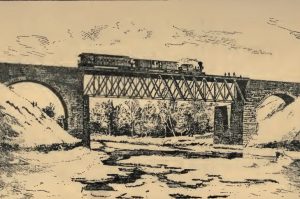 Through the centuries, new designs were developed to build things we needed. As the railroad moved across the nation, track laying came across deep gorges and flat plains. Of course, the flat plains were easy to deal with, and trains could simply go around any hills in the area, but the rivers and gullies were a bigger problem. They needed bridges, and so Charles Collins and Amasa Stone jointly designed a bridge to be used at Ashtabula, Ohio. It was the first Howe-type wrought iron truss bridge built. Collins was worried about the bridge, thinking that it was “too experimental” and needed further evaluation. Nevertheless, higher powers prevailed, and the bridge was built. Collins had been right to be concerned. The bridge lasted just 11 years before it collapsed.
Through the centuries, new designs were developed to build things we needed. As the railroad moved across the nation, track laying came across deep gorges and flat plains. Of course, the flat plains were easy to deal with, and trains could simply go around any hills in the area, but the rivers and gullies were a bigger problem. They needed bridges, and so Charles Collins and Amasa Stone jointly designed a bridge to be used at Ashtabula, Ohio. It was the first Howe-type wrought iron truss bridge built. Collins was worried about the bridge, thinking that it was “too experimental” and needed further evaluation. Nevertheless, higher powers prevailed, and the bridge was built. Collins had been right to be concerned. The bridge lasted just 11 years before it collapsed.
On December 28, 1876, a Lake Shore and Michigan Southern Railway train…the Pacific Express left New York. It struggled along through the drifts and the blinding storm. The train was pulling into Ashtabula, Ohio, shortly before 8:00pm on December 29, 1876, several hours behind schedule. The eleven cars were a heavy burden to the two engines. The leading locomotive broke through the drifts beyond the ravine, and rolled on across the bridge at Ashtabula at less than ten miles an hour. The head lamp could barely be seen because the air was thick with the driving snow. The leading engine reached solid ground, and the engineer had just given it steam…when something in the undergearing of the bridge snapped.
What followed was a horror beyond horrors…not only for the victims, but for the rescuers as well…maybe even more so for the rescuers. As the bridge crumbled beneath the weight of the train, the train and its 159 passengers fell 70 feet into the river below. More than 90 people, passengers and crew, were killed when the train hit the river and ignited into a huge ball of flames. Only the lead engine escaped the fall. As the bridge fell, the engineer gave it a quick head of steam, which tore the draw head from its tender, and the liberated engine shot forward and buried itself in the snow. The engineer escaped with a broken leg. The proportions of the Ashtabula horror are still only approximately known. Daylight, brought with it the opportunity to find and count the saved. It also revealed the fact that two out of every three passengers on the train were lost. Of the 160 passengers who the injured conductor reports as having been on board, fifty nine were found or accounted for as surviving. The remaining 100, burned to ashes or shapeless lumps of charred flesh, were lying under the ruins of the bridge and train. Every possible element of horror was there. First came the crash of the bridge, the agonizing moments of suspense as the seven laden cars plunged down their fearful leap to the icy riverbed. Then the fire, that devoured all that had been left alive by the crash. The water that gurgled up from under the broken ice brought with it another form of death. And finally, the biting blast of freezing air filled with snow, that froze those who had escaped the water and fire.
For the rescuers, the horror had just begun. I can’t think of anything worse than seeing those bodies after they were horribly mangled, drowned, and burned…some beyond recognition, some completely cremated. The number of persons killed cannot be accurately stated, because it is not known exactly how many there were on the train. It is supposed that some of the bodies were entirely consumed in the flames, as well. The official list of those killed and those who have died of their injuries, gives the number as fifty five, but it is suspected to be somewhat higher. There is no death list to report…and in fact, there can be none. There are no remains that can ever be identified. The three charred, shapeless lumps recovered were burned beyond recognition. For the rest, there are piles of white ashes in which were found the crumbling particles of bones. In other places masses of black, charred debris, half under water, which may contain fragments of bodies, but nothing that resembled a human body. It is thought that there may have been a few corpses under the ice, as there were women and children who jumped into the water and sank, but none have been recovered. Periodically, as people began looking for people that were missing around the country, and they were able to place them, as possibly on the train, more supposed victims have been identified…at least there is the possibility that they were a victim.
The Ashtabula, Ohio Railroad Disaster, often referred to simply as the Ashtabula Disaster or the Ashtabula Horror, was one of the worst railroad disasters in American history. The event occurred just 100 yards from the railroad station at Ashtabula, Ohio. It’s topped only by the Great Train Wreck of 1918 in Nashville, Tennessee. Charles Collin, the chief engineer, who knew as few men did the defects of that bridge, but was powerless to repair them, had been listening for this very crash for years. Collins, locked himself in his bedroom and shot himself while the inquest was in progress rather than tell the world all he believed he knew. Collins was found 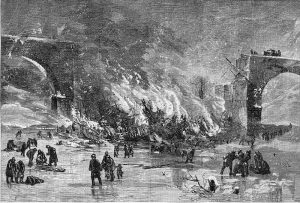 dead in his bedroom of a gunshot wound to the head. He had tendered his resignation to the Board of Directors the previous Monday. Collins was believed to have committed suicide out of grief and feeling partially responsible for the tragic accident, however, a police report at the time suggested the wound had not been self inflicted. Documents discovered in 2001 and an examination of Collins’ skull suggest that he had indeed been murdered. Amasa Stone committed suicide seven years later after experiencing financial difficulties with some foundries he had interests in, suffering from severe ulcers that kept him from sleeping, and scorn from the public over the disaster.
dead in his bedroom of a gunshot wound to the head. He had tendered his resignation to the Board of Directors the previous Monday. Collins was believed to have committed suicide out of grief and feeling partially responsible for the tragic accident, however, a police report at the time suggested the wound had not been self inflicted. Documents discovered in 2001 and an examination of Collins’ skull suggest that he had indeed been murdered. Amasa Stone committed suicide seven years later after experiencing financial difficulties with some foundries he had interests in, suffering from severe ulcers that kept him from sleeping, and scorn from the public over the disaster.
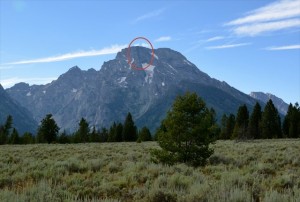 When I was about 10 years old or so, my family and my Uncle Bill’s family went to the Jackson, Wyoming area. While we were stopped at a lookout point for the Teton Mountains, my dad told a story, or maybe read the story about a plane that had crashed on Mount Moran on November 21, 1950. He told us that because of the difficulty in reaching the site, the plane and the remains of the 21 people lost in the crash were never removed from the site. My young mind could not seem to get past the fact that those bodies were still on that mountain top. I had a terrible time sleeping. I don’t know if I felt like we were somehow camping someplace we shouldn’t be, which was silly, because that site was miles from where we were camped. Nevertheless, it bothered me very much at that time. Now, many years later, I would know that the mountain was simply a burial place for the victims of a tragic crash.
When I was about 10 years old or so, my family and my Uncle Bill’s family went to the Jackson, Wyoming area. While we were stopped at a lookout point for the Teton Mountains, my dad told a story, or maybe read the story about a plane that had crashed on Mount Moran on November 21, 1950. He told us that because of the difficulty in reaching the site, the plane and the remains of the 21 people lost in the crash were never removed from the site. My young mind could not seem to get past the fact that those bodies were still on that mountain top. I had a terrible time sleeping. I don’t know if I felt like we were somehow camping someplace we shouldn’t be, which was silly, because that site was miles from where we were camped. Nevertheless, it bothered me very much at that time. Now, many years later, I would know that the mountain was simply a burial place for the victims of a tragic crash.
While I am no longer haunted by the thought of those lost ones buried in the ice at the top of the mountain, I really never lost my curiosity about the crash and just who those people were. Then, a few weeks ago, I found that today would be the 65th anniversary of that crash. It seemed like it was time to find out more about it. The plane, a new Douglas DC-3, was owned by New Tribes Mission. It was on the first leg of a trip to South America. It left Chico, California and was bound for Billings, Montana. The last radio report in was over Idaho Falls, Idaho at 3:48pm. Then it was reported overdue at Billings, leaving the sinking feeling that something tragic had happened. A resort owner said he saw a burning fuselage in the flames far above timberline on the east face of Mount Moran. When the fire subsided, he could see nothing resembling a campfire, which might have indicated survivors. Gaining access to the site was going to prove extremely difficult, and with temperatures seriously low, the chance of anyone making it through that first night were next to none. Of course, you can guess the outcome of the crash. All those on board were lost.
Removing the wreckage and the bodies of the victims proved to be a very difficult, if not impossible task, and in the end, it was decided that the wreckage and the remains would be left on the mountain. The crash site is just north of the top of the handle of Skillet Glacier. Sometimes a glint of the wreckage can be seen to this day on a sunny summer afternoon when the light is just right. The crash site remains a resting place for those lost souls, and hikers who pass the site are expected to show their respect by leaving this mountain gravesite undisturbed. The site is the burial ground for the ten men, four women, and seven children who’s remains are still entombed in the wreckage. I suppose that these days, while the plane might have been left on the mountain, the remains of the victims would have most certainly been removed allowing the families to give them a proper burial.
Hikers who have passed the wreckage have said that it has an eerie feeling. I’m sure it has to do with being so close to the remains of the victims of that horrible crash. I can totally relate to how they felt, because on that day, when we were camping just within sight of the mountain where the wreckage and the victims still remained, I could not sleep. I was not afraid of being haunted or anything silly like that, but rather I guess it felt like I was an intruder, much like the Native Americans felt when the White Man went through their burial grounds. It was just not the right place to be. I think I would feel even more like I was in the wrong place, if I ever hiked that mountain, and came upon that sight. I still have an eerie feeling about it to this day…or maybe it is just a sadness for those lost ones. I’m still not sure about that…to this day.
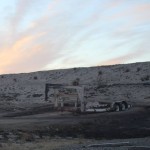
 On October 11, 2015, a wildfire devastated a large area north of Casper, including the area where my nephew, Barry Schulenberg and his wife, Kelli live. While their house was not one that was damaged, they did not escape unscathed. They lost a shed with some lawn equipment in it, fifteen or more trees, a flatbed trailer, and about eight cords of wood, which was enough to heat their home for the coming winter, just to name a few of the things. While insurance will reimburse them for some of the loss, it will not cover all of it, nor will it even begin to reimburse them for the many hours spent cutting all that wood the first time. And the hardest thing to get back…peace of mind.
On October 11, 2015, a wildfire devastated a large area north of Casper, including the area where my nephew, Barry Schulenberg and his wife, Kelli live. While their house was not one that was damaged, they did not escape unscathed. They lost a shed with some lawn equipment in it, fifteen or more trees, a flatbed trailer, and about eight cords of wood, which was enough to heat their home for the coming winter, just to name a few of the things. While insurance will reimburse them for some of the loss, it will not cover all of it, nor will it even begin to reimburse them for the many hours spent cutting all that wood the first time. And the hardest thing to get back…peace of mind.
People would call them lucky, that so much of their property was spared, but I don’t really think anyone who lost anything in that fire, that took 10,000 acres, 12 homes, a number of animals, and several other structures, considers themselves lucky…except that they made it out alive. I still don’t consider that luck. I believe it was the prayers of the people of Casper and others around the nation that kept the loss to the relative minimum that it ended up being, compared to other large fires.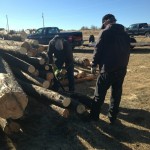
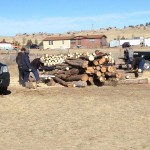
In the aftermath, many people have donated money and other needed items to those who suffered loss that dreadful day, and many will continue to do so. There is no way for me to talk about them all, but they know how much the people who they have helped appreciated it. Help after a loss never goes unnoticed. It is a show of love, kindness, and compassion that can never be repaid. People helping people…the giving spirit. It is what people do for those in need.
As for Barry and Kelli Schulenberg, a special family and friends benefit took place yesterday, when a dozen people converged on my brother-in-law and sister-in-law, Ron and Rachel Schulenberg’s place, where thankfully, Barry and Kelli still had some wood, waiting to be cut. Those dozen people spent most of the day cutting, loading, and unloading the ten cords of wood, that now sits where the first eight cords had been at Barry and Kelli’s place. I know that they already feel much better about the coming winter, because without all that wood, it would have been a much more expensive winter in the heating department.

 The things that Barry, Kelli, and the other fire victims lost in the fire will at least partially be replaced, but the thing you can’t put a value on is the helping hands of the people who stepped up to help you rebuild your life. The fire victims lost a lot of things, but things can be replaced. Nevertheless, cleanup, replanting, re-cutting of wood, and so many other things that had to be done after a fire, take time and effort. I have to give a lot of credit to anyone who helped to put the lives of the fire victims back together. The kindness of those helping hands was a blessing that will never be forgotten.
The things that Barry, Kelli, and the other fire victims lost in the fire will at least partially be replaced, but the thing you can’t put a value on is the helping hands of the people who stepped up to help you rebuild your life. The fire victims lost a lot of things, but things can be replaced. Nevertheless, cleanup, replanting, re-cutting of wood, and so many other things that had to be done after a fire, take time and effort. I have to give a lot of credit to anyone who helped to put the lives of the fire victims back together. The kindness of those helping hands was a blessing that will never be forgotten.
 As the fourteenth anniversary of the September 11th attacks approached, movies that had been filmed following those horrible events began to show up on television again. I think I’ve already watched each and every one of them, but I always feel compelled to watch them again. It isn’t out of a morbid sense of curiosity, but rather as a reminder that there are people out there who are so evil that it is beyond our ability to comprehend. It is also a way to remind myself that there are heroes out there who set aside self, no matter what the danger, in an effort to save others.
As the fourteenth anniversary of the September 11th attacks approached, movies that had been filmed following those horrible events began to show up on television again. I think I’ve already watched each and every one of them, but I always feel compelled to watch them again. It isn’t out of a morbid sense of curiosity, but rather as a reminder that there are people out there who are so evil that it is beyond our ability to comprehend. It is also a way to remind myself that there are heroes out there who set aside self, no matter what the danger, in an effort to save others.
I like to hope that I would be one of those people who come together to save others, but I don’t think that the average citizen really knows what they would do, until they are placed in that position. Our flight instincts seem to be based on just how big a danger we perceive ourselves to be facing. I don’t think that I could leave someone in trouble, but I don’t know how I would feel about actually running into a building like the World Trade Center on September 11.
As I was watching the movie, I was reminded that there were a number of people who were simply never found 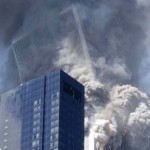 at the World Trade Center site. Never found!! In fact, there were over 1000 people who were never found. It was like they were simply vaporized. Of course, there might be pieces of them in the many, some small enough to fit in a test tube, pieces of human remains that have not been identified. It is shocking and sad to me to think that there are actually people who have never been given closure concerning their loved ones. All they know is that their loved ones were killed on September 11, 2001. They don’t know if they suffered, or if it was instant. There is simply no way to know. And that is horrifically hard. I don’t mean to sound morbid, but I have a really hard time when I think about the fact that in just a few hours, more than 1,000 people simply disappeared. In our world of DNA matches and so many other methods of identifying people, and so many pieces of bodies that have been found, I just don’t understand how those people could simply be nowhere, but they are. I think that true closure often comes from being able to view the body, and have a funeral using the real body of the loved one. In the absence of that body, the mind plays tricks on us. We hope that maybe they somehow survived and simply have amnesia or something. Even though we know that is probably wrong.
at the World Trade Center site. Never found!! In fact, there were over 1000 people who were never found. It was like they were simply vaporized. Of course, there might be pieces of them in the many, some small enough to fit in a test tube, pieces of human remains that have not been identified. It is shocking and sad to me to think that there are actually people who have never been given closure concerning their loved ones. All they know is that their loved ones were killed on September 11, 2001. They don’t know if they suffered, or if it was instant. There is simply no way to know. And that is horrifically hard. I don’t mean to sound morbid, but I have a really hard time when I think about the fact that in just a few hours, more than 1,000 people simply disappeared. In our world of DNA matches and so many other methods of identifying people, and so many pieces of bodies that have been found, I just don’t understand how those people could simply be nowhere, but they are. I think that true closure often comes from being able to view the body, and have a funeral using the real body of the loved one. In the absence of that body, the mind plays tricks on us. We hope that maybe they somehow survived and simply have amnesia or something. Even though we know that is probably wrong.
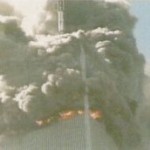
As this fourteenth anniversary of that horrible day arrives, I pray for those who lost loved ones, and those who will never know what happened to their loved ones. I pray that they are able to have emotional closure, even if they can’t have full closure. For the rest of us, I hope that we will never forget what happened that day, the people who died, and the people who did this. Terror and terrorists continue to exist in our world, and they don’t care if their victims were tolerant of their beliefs or not. They have one agenda, and one agenda only, to kill all infidels, because in their minds, that is their obligation and their right. We must stay alert, lest we find ourselves open to another attack.

